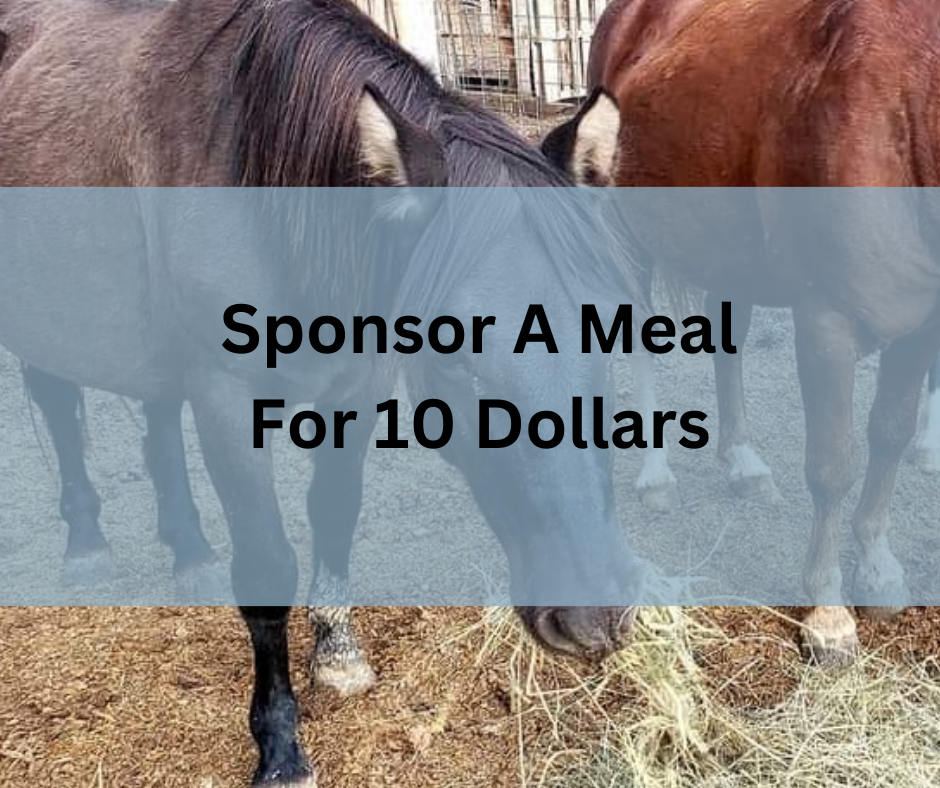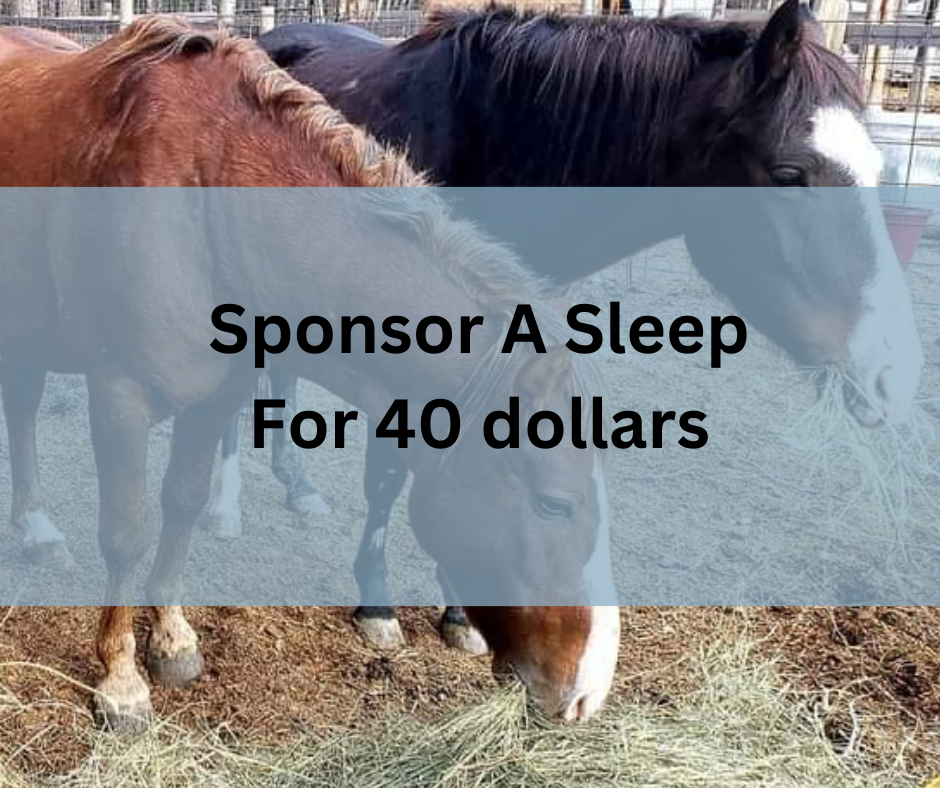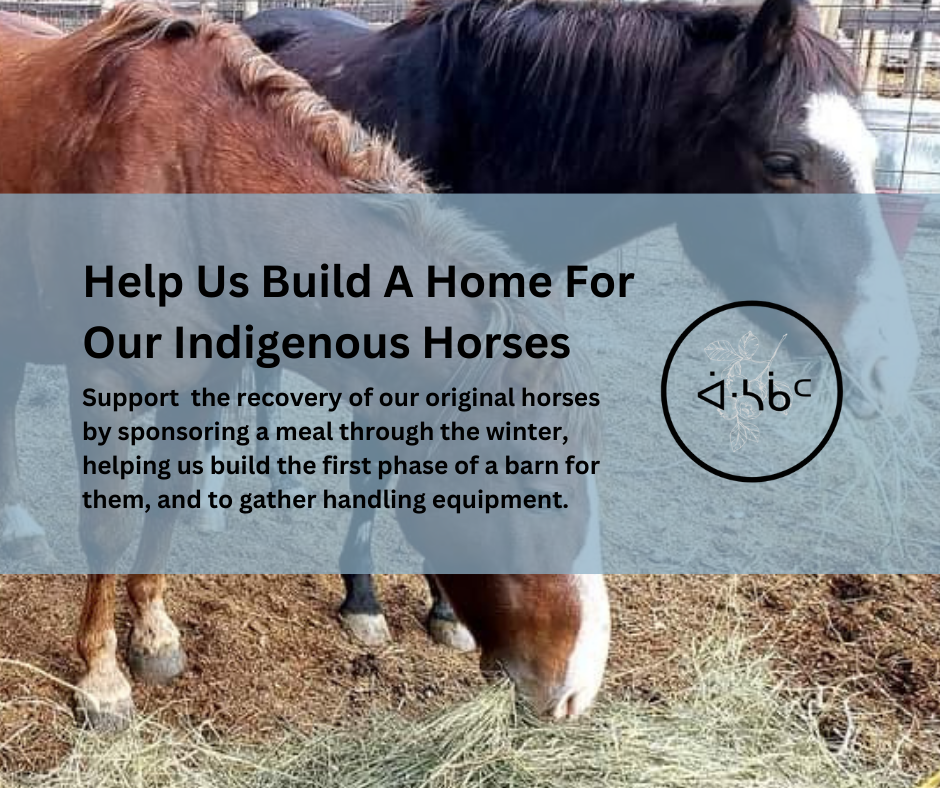Be A Sponsor!
The recovery of our population of Indigenous horses is important for reclaiming our relationships with the land. We invite you to support this journey as we help our horse relatives recover after their near eradication.
Sponsor A Meal
See how you can support these incredible horses by sponsoring a meal for 10 dollars a day throughout the winter!
Sponsor A Sleep
Help keep the horses warm and comfortable through the winter by sponsoring a bale of straw for 40 dollars!
Build Their Home
Help us build a barn, build a 20 acre paddock, and gather the equipment we need for the horses to live a beautiful life here on the land at Wâsakâm through our GoFundMe!
Their Tragic History
The common story we hear about horses in North America is that they arrived with the Spanish. However, this story is a fiction, and even at the time of first contact with Europeans, our horses were written about. These horses, often referred to as ponies, have lived here for as long as we have, if not longer, and we are excited to share their story with you.
Not only did Indigenous people here in Ministik (North, Central and South America) have horses, there are some that are still alive today despite incredible efforts to eradicate them.
“Settler’s treatment of Ojibway horses appeared to mirror the treatment of Canada’s Indigenous people in general. An Indian Affairs report referred to them as “worthless, useless little ponies we need to get rid of.” Despite their heritage as the continent’s only native horses – equipped with speed, strength and stamina – ranchers only saw a pest to eradicate. Ignoring their cultural significance as Indigenous companions and spiritual allies, the horses were hunted, shipped off to glue or dog food factories, and quietly destined for oblivion. In 1977, Canadian authorities ordered the destruction of the last four Ojibway horses in Canada. In a plot worthy of a Disney movie, a late-night clandestine rescue operation was able to smuggle these survivors to safety across the US border. ” – Robin Esrock https://canadiangeographic.ca/articles/ojibway-spirit-horses-gallop-into-view/
Our original horses narrowly escaped extinction, due to a purposeful extermination effort over hundreds of years.
In 1977, there were 4 left, and they were ordered to be killed. But, in an effort that those who love this breed will be forever grateful for, the remaining horses were taken across the border and not only protected, but revived.
Decades later there are over 250 of these horses, with many caretakers across Ministik (in Alberts, Saskatchewan, Manitoba, Ontario and in other palces). For each caretaker (we tend to avoid the word owner), tending to these animals is a labour of love. And, for us here at Wâsakâm, its an act of reclamation for our family, our nation, and all Indigenous peoples. We are reclaiming kinship with these horses and the land.
My Family’s Story
I was told by ketehayah (an elder) that we should always try to find the roles our family played in community. These roles are passed down through families, along with the associated knowledge and teachings. Colonization interrupted this lineage of skills, knowledge, teachings and roles in community. However, I am blessed to know much about my family’s roles in community. And, one important way we served community was through horses.
One of my Chapans (specifically my Great Great Great Grandfather Onesime Falcon) was a horse trainer. He has a way with horses. He spent his time working with them. “Softening” them. Or in today’s words…training them. This relationship with horses was an important one. It was a part of my family’s identity. Horses were vital on our buffalo hunts, and as we travelled across the plains.
However, Onesime was murdered in Winnipeg in the early 1900’s and my family’s life took a drastic turn. It was understood in the community that he was robbed and killed, likely after trading horses.
So, for my family, reclaiming this relationship with horses is one of reconnection. We are re-establishing a long standing and important relationship. We are healing ancestral wounds.
Why These Horses?
I became aware that there were survivors of our original horses about 15 years ago. I read a very short online article that indicated the horses were being protected and that efforts were being made to recover their numbers.
I felt then, I would find these horses and I would have a relationship with them. It wasn’t an urgency. In fact, back then, life was different for us. We lived in Southern Alberta, we lived in a city. We couldn’t have housed a family of horses…not even a single one. I simply felt 100% assured, that someday those horses would find me.
When we moved off grid, started farming, and finally had space for horses, I thought many times of looking for them. I would check online to see if there was any more information. And, now and then there was! But, it still didn’t feel like it was time.
Finally, after our home burned down, and we were starting to think of rebuilding, a voice said, it’s time. Look now. And, I have learned to listen to that voice. I dug in online and found MANY articles. Articles stating that caretakers were being actively sought…and that there were families of these horses NEAR ME!
I put the word out that we were looking to host these horses and…she answered.
A caretaker near me had been looking for us too! In a bold and beautiful act of reconciliation, she wanted to help facilitate the return of these Indigenous horses to Indigenous peoples.
Everything clicked. We all felt heard and affirmed. And, we felt passionate about ensuring these horses were brought back to the land, and back into relationship with our nations.
We had been preparing the land and our minds for the arrival of the horses, and we figured Spring of 2024 would be just right. However, spirit had other plans. I got a message from their caretaker indicating that the situation had changed, and asking if I could take a group…in two weeks.
As I tend to do when spirit prompts, I said yes and got to work. We moved sheep and cattle, cleaned up a winter pen, clearing out deadfall trees, removing stumps, and fixing fences. With only a couple of hours to spare, we finished the work and welcomed the horses.
We are thrilled to have them here. Their presence is a healing blessing in so many ways.
However, my family has also suffered a great deal of loss in the last couple of years. We lost our home and everything we had to a house fire in April of 2022 and along with community have bourn the costs of rebuilding a home. We are still recovering financially, and we need the support of the community to care for these beautiful animals. We could do it on our own, but at great cost to our family in terms of wellbeing. We know they are meant to be here. And we are willing to do the work. But we also know that this relationship we are rebuilding isn’t for us alone. Its for our community.
Your Part In This Story
And so, we are inviting you in. To support these incredible beings. And, we have several ways you can help if you’re willing.
Be a part of caring for these Indigenous horses by;
- Sponsoring a meal! For 10 dollars a day through the winter, you can help nourish these beautiful beings.
- Sponsoring a sleep! For 40 dollars, you can ensure these incredible beings are warm and comfortable through the winter with straw bedding!
- Sponsoring equipment! Two of the horses are already familiar with halters and leads…but we need to get them some equipment now that they are here! Help us by donating for some tack!
- Building a barn with us! We expect foals come spring and having a shelter available to keep them safe from variable spring weather is important. Donate to our building materials fund!
Come spring, we will be busy fencing 20 acres and, this will be our biggest job of the year. It will take money, time, and so much effort. But we know that with you…we can get it done and create a beautiful safe home on the land for these original horses.
Our Goals
Our first goal of 5,000 dollars will allow us to purchase the hay the horses will need through the winter. It will also allow us to build a run in shelter to give them reprieve from harsh winter weather. This shelter will eventually become the side of the barn we will build for them. Finally, this first goal will allow us to purchase handling equipment like halters and leads to ensure the parents and babies are familiar with being handled and in a safe and positive relationship with us.
Our second goal of 10,000 dollars will allow us to complete the barn which will not only allow us to offer shelter to the horses in severe winter weather, but will also offer space for visits from the vet, ferrier, and for allowing moms with babies some privacy after foaling. This second goal will also allow us to fence 20 acres in order to offer this family of horses a safe and spacious home.


